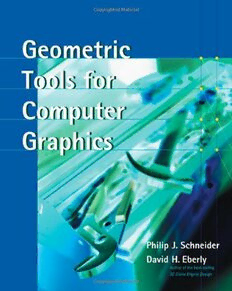Table Of ContentGeometric Tools for
Computer Graphics
TheMorganKaufmannSeriesinComputerGraphicsandGeometricModeling
SeriesEditor:BrianA.Barsky,UniversityofCalifornia,Berkeley
GeometricToolsforComputerGraphics Andrew Glassner’s Notebook: Recreational Computer
PhilipSchneiderandDavidEberly Graphics
AndrewS.Glassner
LevelofDetailfor3DGraphics
David Luebke, Martin Reddy, Jonathan D. Cohen, WarpingandMorphingofGraphicalObjects
Amitabh Varshney, Benjamin Watson, and Robert Jonas Gomes, Lucia Darsa, Bruno Costa, and Luiz
Huebner Velho
JimBlinn’sCorner:DirtyPixels
Texturing&Modeling:AProceduralApproach,
JimBlinn
ThirdEdition
DavidS.Ebert,F.KentonMusgrave,DarwynPeachey, Rendering with Radiance: The Art and Science of
KenPerlin,andStevenWorley LightingVisualization
GregWardLarsonandRobShakespeare
JimBlinn’sCorner:Notation,Notation,Notation
JimBlinn IntroductiontoImplicitSurfaces
EditedbyJulesBloomenthal
UnderstandingVirtualReality
JimBlinn’sCorner:ATripDowntheGraphicsPipeline
WilliamShermanandAlanCraig
JimBlinn
DigitalVideoandHDTVAlgorithmsandInterfaces
InteractiveCurvesandSurfaces:AMultimediaTutorial
CharlesPoynton
onCAGD
Pyramid Algorithms: A Dynamic Programming Ap- AlynRockwoodandPeterChambers
proachtoCurvesandSurfacesforGeometricModeling WaveletsforComputerGraphics:TheoryandApplica-
RonGoldman tions
EricJ.Stollnitz,TonyD.DeRose,andDavidH.Salesin
Non-PhotorealisticComputerGraphics:Modeling,
Rendering,andAnimation PrinciplesofDigitalImageSynthesis
ThomasStrothotteandStefanSchlechtweg AndrewS.Glassner
CurvesandSurfacesforCAGD:APracticalGuide, Radiosity&GlobalIllumination
FifthEdition Franc¸oisX.SillionandClaudePuech
GeraldFarin Knotty:AB-SplineVisualizationProgram
JonathanYen
SubdivisionMethodsforGeometricDesign:A
ConstructiveApproach UserInterfaceManagementSystems:Modelsand
JoeWarrenandHenrikWeimer Algorithms
DanR.Olsen,Jr.
ComputerAnimation:AlgorithmsandTechniques
MakingThemMove:Mechanics,Control,and
RickParent
AnimationofArticulatedFigures
TheComputerAnimator’sTechnicalHandbook Edited by Norman I. Badler, Brian A. Barsky, and
LynnPocockandJudsonRosebush DavidZeltzer
AdvancedRenderMan:CreatingCGIforMotionPictures GeometricandSolidModeling:AnIntroduction
AnthonyA.ApodacaandLarryGritz ChristophM.Hoffmann
CurvesandSurfacesinGeometricModeling:Theoryand AnIntroductiontoSplinesforUseinComputerGraphics
Algorithms andGeometricModeling
JeanGallier RichardH.Bartels,JohnC.Beatty,andBrianA.Barsky
Geometric Tools for
Computer Graphics
Philip J. Schneider
David H. Eberly
PublishingDirector DianeCerra
PublishingServicesManager EdwardWade
SeniorDevelopmentalEditor BelindaBreyer
ProjectManagement ElisabethBeller
CoverDesign RossCarronDesign
CoverImage Getty/SpencerJones
TextDesign RebeccaEvans&Associates
Composition WindfallSoftware,usingZzTEX
TechnicalIllustrationandFigureRevision DartmouthPublishing,Inc.
Copyeditor KenDellaPenta
Proofreader JenniferMcClain
Indexer SteveRath
Printer TheMaple-VailBookManufacturingGroup
Designationsusedbycompaniestodistinguishtheirproductsareoftenclaimedastrademarks
orregisteredtrademarks.InallinstancesinwhichMorganKaufmannPublishersisawareofa
claim,theproductnamesappearininitialcapitalorallcapitalletters.Readers,however,should
contacttheappropriatecompaniesformorecompleteinformationregardingtrademarksand
registration.
MorganKaufmannPublishers
AnimprintofElsevierScience
340PineStreet,SixthFloor
SanFrancisco,CA94104-3205
www.mkp.com
©2003byElsevierScience(USA)
Allrightsreserved
PrintedintheUnitedStatesofAmerica
07 06 05 04 03 5 4 3 2 1
Nopartofthispublicationmaybereproduced,storedinaretrievalsystem,ortransmittedin
anyformorbyanymeans—electronic,mechanical,photocopying,recording,orotherwise—
withoutthepriorwrittenpermissionofthepublisher.
LibraryofCongressControlNumber:2002107242
ISBN:1-55860-594-0
Thisbookisprintedonacid-freepaper.
Tomywife,Suzanne,andmysons,DakotaandJordan —PS
Tomywife,Shelly,forherpatiencethroughyetanotherbook —DE
Foreword
EricHaines
OnmyshelfisanoldbookcalledAProgrammer’sGeometry,byBowyerandWood-
wark.Itwaspublishedin1983,reprintedtwicein1984and1985,butthendiscontin-
ued.OvertheyearsIhaveguardedmycopy,keepingcarefultrackofwhoborrowed
it.CheckingontheWebtoday,Ifoundsixusedcopiesranginginpricefrom$50to
$100.Thisisahighpricerangeforapaperbackbookonly140pagesinlength.The
reasonthebookisworththismuchisthatitdescribeshowtoprogramvariousop-
erationsrelatedto2Dgeometry.Itdoesnotjustpresentgeometricformulae;italso
describesefficientwaystoaccomplishtasksandgivescodesnippets(inFORTRAN).
Now,almosttwodecadeslater,wehaveaworthysuccessortothatslimvolume.
Thebookbeforeyoudistillsahugeamountofliteratureongeometryintothatwhich
ismostusefultoprogrammers.Thefieldofcomputergraphicshasevolvedconsid-
erably since 1983, and this volume reflects those advances. Due to the continuing
improvement in computer processor performance, operations that once were only
part of offline analysis packages are now commonly done in interactive programs.
Polygontriangulation,collisiondetectionandresponse,andsurfacemodellingand
modificationarenowpossibleatreal-timerates.Thisbookgivessolidexplanations
andcodetoperformtheseandmanyotheralgorithms.
Beyondprovidingasolidreferenceforawiderangeofgeometry-relatedtasks,this
volumealsopresentstheunderpinningsofthetheorybehindthealgorithms.Rather
thanemployapurecookbookapproach, whichcanleavethereaderwithrunnable
codeandnocomprehensionofhowitworks,theauthorsexplainkeyconcepts.This
approachmakeseachalgorithmatoolthat,furtheron,canberecombinedwithother
tools.
Thedynamicnatureofcomputergraphicsmakesitaparticularlyinterestingarea
of study. Research and implementation of rendering methods respond to changes
in the underlying hardware. For example, in the field of interactive rendering, the
emergingprogrammablenatureofthegraphicsacceleratorhaschangedtherelative
costsofdifferenttechniques.Onabroaderscale,theevolutionoftheCPUhasmade
memory access and caching rise in importance, compared to the older practice of
minimizingthenumberofoperations(e.g.,countingmultipliesandadds).However,
theunderlyingtheoryandalgorithmsfor,say,findingtheconvexhullofanobjectare
considerably more long-lasting, less affected by changes. Of course, more efficient
algorithmsarefoundovertime,andhardwareinfluenceswhichmethodcurrentlyis
consideredthefastest,butthebasicprinciplesremainthesame.Yearsafteryouhave
vii
viii Foreword
shedyourbooksonDirectX9orIntel’s64-bitItaniumarchitecture,youarelikelyto
havesomeeditionofthisbookonyourshelf.
AnotherreasonthisbookwillhaveincreasedstayingpoweristheInternet.Iam
thearchivistforthe“GraphicsGems”seriescoderepository.Thecodeforthisseries
ofbooks, includingcodebyPhilipSchneider, waswiselymadefreeforreusewhen
theserieswaspublishedintheearly1990s.Overtheyearsreadershavesentinbug
fixes and improvements to the code base, so benefiting all. Similarly, Dave Eberly
hascarefullymaintainedhis“MagicSoftware”Website(www.magic-software.com),
whichincludesworkingversionsofmanyofthealgorithmspresentedinthisvolume.
Called “a national treasure” by a leading researcher in computer graphics, this site
allows addenda and corrigenda to be made available instantly whenever they are
needed. Code does not rust; it improves with age when properly supported. This
is particularly true for algorithms in this book as they are not tied to particular
hardware,networkprotocols,orothertransientobjects.
OvertheyearsIandmanyothershaveusedalgorithmsandcodebytheauthors
inproductsandresearchprojects.Anhourofaprogrammer’stimeoftencostsmore
than the price of a book. By this measure, you hold a volume potentially worth
thousandsofdollars.ThatitcanbepurchasedforafractionofthiscostIconsider
amodernmiracle.Theamountofinformationcrammedintothisbookisincredible.
Themathematicsmaybeslowgoingattimes,butthealternativewouldbetoinclude
wordier and less precise descriptions of fewer algorithms. If you are looking for a
lightweight text you can read through and check off your list, keep searching. This
book sometimes requires effort and struggle to fully comprehend but then, so do
mostoftheworthwhilethingsintheworld.
1 Introduction ..................................................................... 1
How to Use This Book ............................................................ 1
Issues of Numerical Computation........................................... 2
Low-Level Issues................................................................................. 2
High-Level Issues................................................................................ 4
A Summary of the Chapters ................................................... 6
2 Matrices and Linear Systems......................................... 9
Introduction ............................................................................. 9
Motivation ............................................................................................ 9
Organization ........................................................................................ 13
Notational Conventions ....................................................................... 14
Tuples..................................................................................... 14
Definition.............................................................................................. 15
Arithmetic Operations.......................................................................... 16
Matrices .................................................................................. 16
Notation and Terminology ................................................................... 17
Transposition....................................................................................... 17
Arithmetic Operations.......................................................................... 18
Matrix Multiplication............................................................................. 20
Linear Systems ....................................................................... 24
Linear Equations.................................................................................. 24
Linear Systems in Two Unknowns ...................................................... 26
General Linear Systems...................................................................... 29
Row Reductions, Echelon Form, and Rank......................................... 30
Square Matrices...................................................................... 32
Diagonal Matrices................................................................................ 32
Triangular Matrices.............................................................................. 34
The Determinant.................................................................................. 34
Inverse................................................................................................. 38
Linear Spaces......................................................................... 41
Fields................................................................................................... 41
Definition and Properties ..................................................................... 42
Subspaces........................................................................................... 43
Linear Combinations and Span........................................................... 43
Linear Independence, Dimension, and Basis...................................... 44
Linear Mappings ..................................................................... 45
Mappings in General ........................................................................... 45
Linear Mappings .................................................................................. 47
Matrix Representation of Linear Mappings.......................................... 49
Cramer’s Rule...................................................................................... 50
Eigenvalues and Eigenvectors ............................................... 52
Euclidean Space..................................................................... 54
Inner Product Spaces.......................................................................... 54
Orthogonality and Orthonormal Sets................................................... 55
Least Squares......................................................................... 56
Recommended Reading......................................................... 60
3 Vector Algebra................................................................. 63
Vector Basics.......................................................................... 63
Vector Equivalence.............................................................................. 63
Vector Addition .................................................................................... 64
Vector Subtraction............................................................................... 65
Vector Scaling ..................................................................................... 65
Properties of Vector Addition and Scalar Multiplication....................... 66
Vector Space .......................................................................... 69
Span.................................................................................................... 70
Linear Independence........................................................................... 71
Basis, Subspaces, and Dimension...................................................... 71
Orientation ........................................................................................... 73
Change of Basis .................................................................................. 75
Linear Transformations........................................................................ 76
Affine Spaces.......................................................................... 80
Euclidean Geometry............................................................................ 84
Volume, the Determinant, and the Scalar Triple Product .................... 94
Frames ................................................................................................ 96
Affine Transformations............................................................ 98
Types of Affine Maps........................................................................... 103
Composition of Affine Maps................................................................. 103
Barycentric Coordinates and Simplexes................................. 104
Barycentric Coordinates and Subspaces ............................................ 106
Affine Independence ........................................................................... 106
4 Matrices, Vector Algebra, and Transformations .......... 109
Introduction ............................................................................. 109
Matrix Representation of Points and Vectors ......................... 110
Addition, Subtraction, and Multiplication................................. 113
Vector Addition and Subtraction.......................................................... 113
Point and Vector Addition and Subtraction.......................................... 114
Subtraction of Points ........................................................................... 115
Scalar Multiplication............................................................................. 115
Products of Vectors ................................................................ 115

